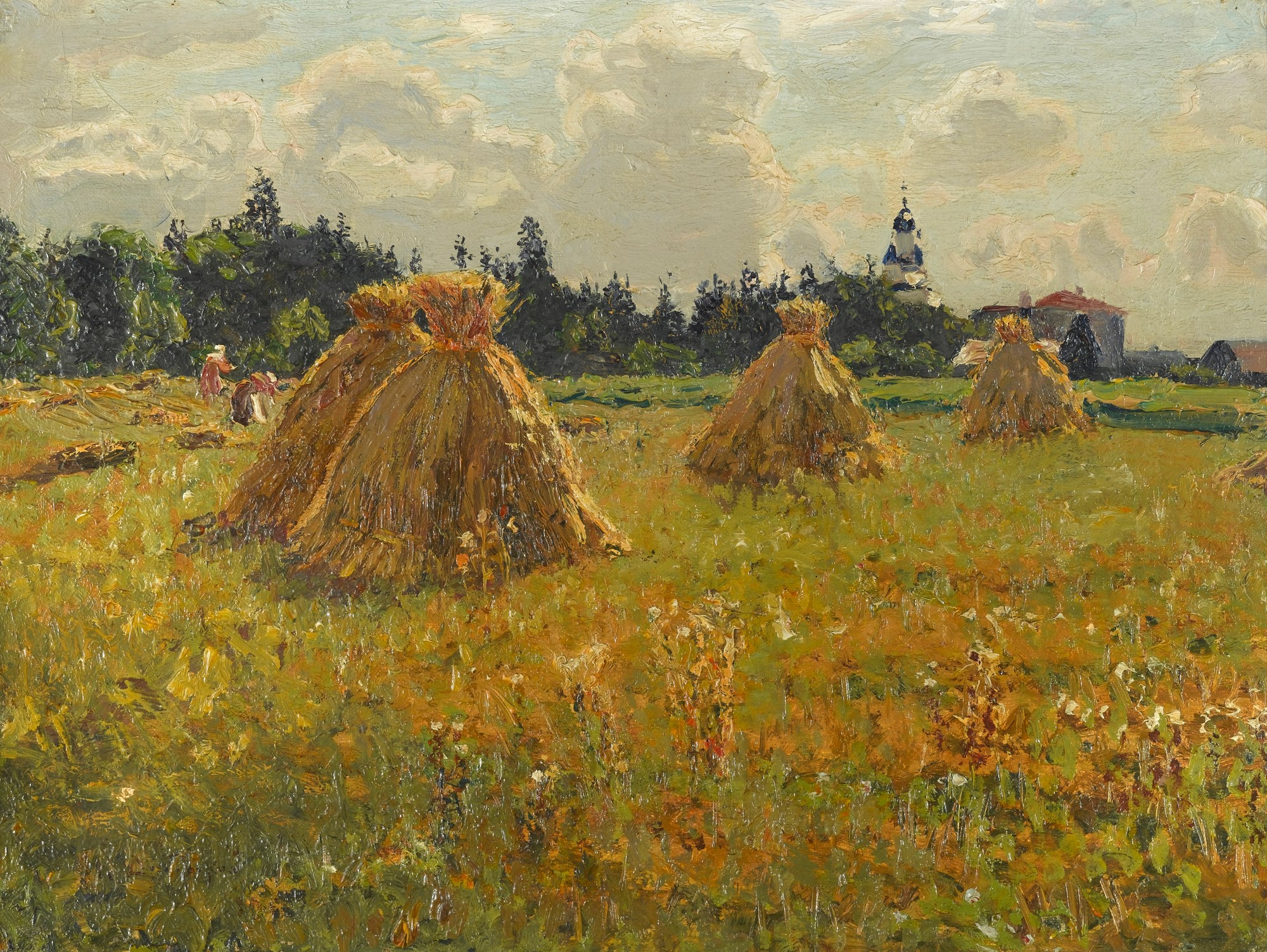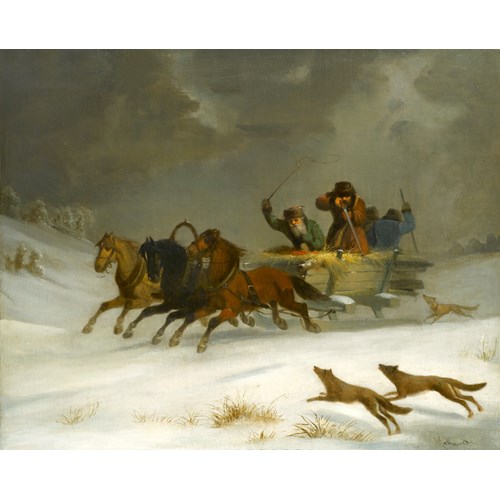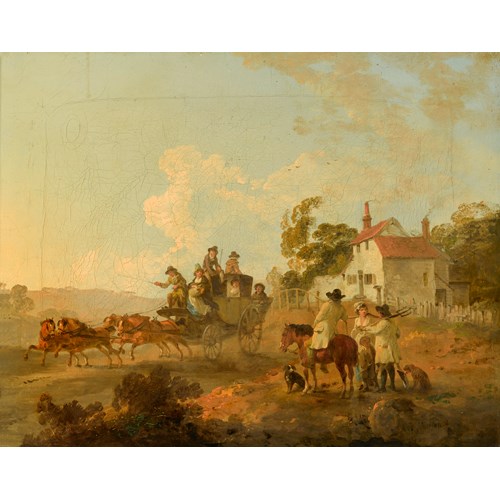Marketplace
Stooks
Nikolai Nikanorovich Dubovskoy
Stooks
Epoque 1850-1900, 19th century, 20th century
Origine Russia
Medium Oil on panel
Dimension 28 x 37 cm (11 x 14⁵/₈ inches)
On a summers day straw is being by harvested by two women in the background. The large stooks in the foreground evidence the amount of work already achieved during the busy harvest. These stooks rhythmically lead the eye back into the painting, where the shape is echoed in the farm building and church in the distance. These buildings, together with the edge of the wood, limit the horizon, forcing the viewer to focus on the foreground which gives the stooks a sense of looming monumentality. The warm sunshine floods the picture picking out the golds and greens of the field. Nikolai Nikanorovich Dubovskoy’s treatment of light is exquisite, particularly on his modelling of the stooks themselves. The work is an almost idealised vision of nature, a eulogy to the humble simplicity of rural life.
Dubovskoy worked primarily as a landscape painter, and although his work within this genre was wide ranging, he often returned to the subject of the harvest. Burnt Rye, is a more panoramic work than Stooks, but shares certain qualities such as the interest of sunlight dispersing across the landscape. There is even less human activity in Burnt Rye than in the present work, and due to this emptiness and the hulking nature of the haystacks, both paintings create a quiet, contemplative mood. In contrast, in Harvest, has a greater sense of activity, with the figures hard at work in the foreground. Dubovskoy has executed Harvest with the same short thick brushstrokes that he uses in Stooks, and the impasto gives the work a sense expressive immediacy.
Dubovskoy’s artistic talent was apparent from an early age, when he would copy pictures from illustrated magazines. At the age of seventeen, he was sent to St. Petersburg to the Imperial Academy of Arts, where he studied under one of the fathers of Russian landscape painting, Baron Mikhail Konstantinovich Klodt von Jurgensburg. Having graduated in 1881, Dubovskoy decided to travel throughout Europe and the Middle East before returning to Russia, where he forged a reputation as one of the country’s greatest landscape painters.
Dubovskoy’s work within the landscape genre were extremely varied. In addition to agricultural scenes, such as Stooks, he depicted other humble, rustic landscapes with villages and cottages. In contrast to these calm simple subjects he also often depicted the sublime, through studies of storms, mountains and waterfalls. Numerous river and marine scenes also feature in his work, as do snow-covered, winter landscapes. This diversity also extended to his technique, which initially was tight and controlled, revealing the influence of Klodt, but became progressively looser and more fluid as his career progressed. However, his works were always underpinned by an excellent understanding of composition.
Dubovskoy joined the Peredvizhniki in 1884 and went on to become one of their most important and influential members. However, his reputation was not confined to Russia and his work was exhibited throughout Europe. He was a prolific painter and Stooks stands as a fine demonstration of why he achieved such popularity and success.
We are grateful to Vladimir Petrov for confirming the attribution of this work.
Dubovskoy worked primarily as a landscape painter, and although his work within this genre was wide ranging, he often returned to the subject of the harvest. Burnt Rye, is a more panoramic work than Stooks, but shares certain qualities such as the interest of sunlight dispersing across the landscape. There is even less human activity in Burnt Rye than in the present work, and due to this emptiness and the hulking nature of the haystacks, both paintings create a quiet, contemplative mood. In contrast, in Harvest, has a greater sense of activity, with the figures hard at work in the foreground. Dubovskoy has executed Harvest with the same short thick brushstrokes that he uses in Stooks, and the impasto gives the work a sense expressive immediacy.
Dubovskoy’s artistic talent was apparent from an early age, when he would copy pictures from illustrated magazines. At the age of seventeen, he was sent to St. Petersburg to the Imperial Academy of Arts, where he studied under one of the fathers of Russian landscape painting, Baron Mikhail Konstantinovich Klodt von Jurgensburg. Having graduated in 1881, Dubovskoy decided to travel throughout Europe and the Middle East before returning to Russia, where he forged a reputation as one of the country’s greatest landscape painters.
Dubovskoy’s work within the landscape genre were extremely varied. In addition to agricultural scenes, such as Stooks, he depicted other humble, rustic landscapes with villages and cottages. In contrast to these calm simple subjects he also often depicted the sublime, through studies of storms, mountains and waterfalls. Numerous river and marine scenes also feature in his work, as do snow-covered, winter landscapes. This diversity also extended to his technique, which initially was tight and controlled, revealing the influence of Klodt, but became progressively looser and more fluid as his career progressed. However, his works were always underpinned by an excellent understanding of composition.
Dubovskoy joined the Peredvizhniki in 1884 and went on to become one of their most important and influential members. However, his reputation was not confined to Russia and his work was exhibited throughout Europe. He was a prolific painter and Stooks stands as a fine demonstration of why he achieved such popularity and success.
We are grateful to Vladimir Petrov for confirming the attribution of this work.
Epoque: 1850-1900, 19th century, 20th century
Origine: Russia
Medium: Oil on panel
Signature: Indistinctly signed in Cyrillic (lower left)
Dimension: 28 x 37 cm (11 x 14⁵/₈ inches)
Plus d'œuvres d'art de la Galerie









